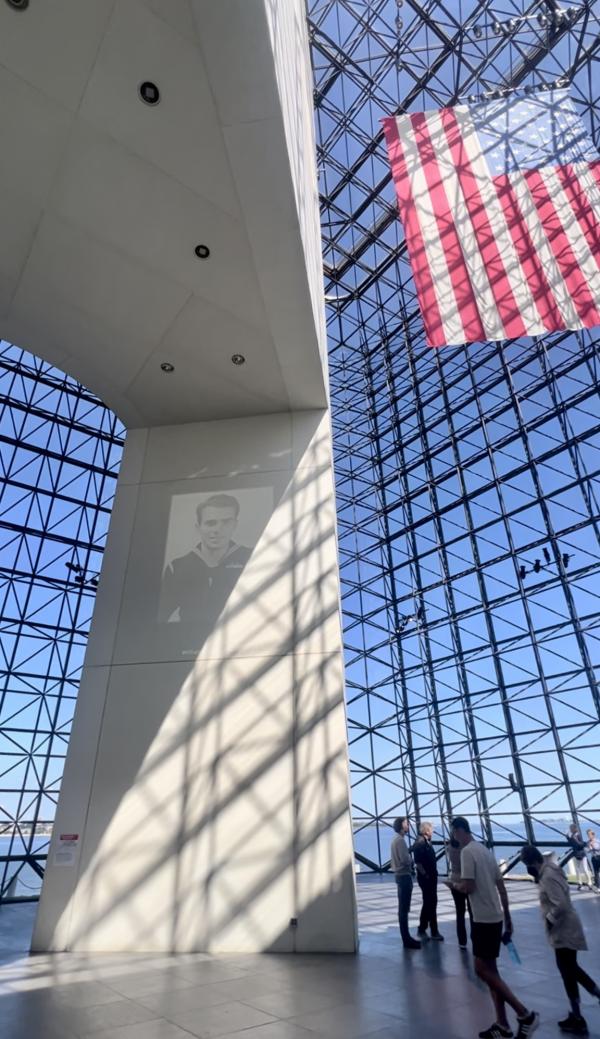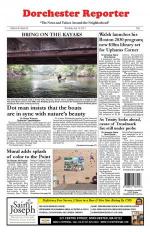September 28, 2023

The attack on Pearl Harbor in December 1941 united millions of Americans with the goal of winning a world war that had been ongoing for two years in Europe and Asia. Hundreds of millions of words about wartime accomplishments and heroics by Americans have been shared by participants and historians over the 82 years since the attack on Hawaii, but some of the stories of marginalized groups who served during the conflict have too often gone untold. The JFK Presidential Library and Museum’s current exhibit, “Service and Sacrifice: World War II — A Shared Experience,” seeks to change that situation.
The interactive experience at the library on Columbia Point features photos, documents, artifacts, and film footage. Visitors are welcomed with a brief explanation of the exhibit and a collage of wartime photos in black and white. The display continues with in a timeline that follows the war from beginning to end. With each step, museumgoers are offered a glance at life in war from 1939 on.
Participants conclude their experience in the library’s main pavilion, where they come upon a special section of the exhibit, a display of more than 150 photos of WWII service men and women from greater Boston.
“We wanted it to be broader than the Kennedy experience, so we wanted to look at the stories of other individuals,” said supervisory museum curator Janice Hodson, the Kennedy name a reference to Joseph P. Kennedy Jr., and his brother John, the future president, and their military service during the war. “When you look at these other individuals, their experience was very much colored by race and gender.”
Hodson and the exhibit team spoke with veteran groups and contacted community members through local papers. In doing so they successfully crowdsourced photos of veterans in uniform that will be projected in the pavilion as a continuous slideshow. In total, the entire exhibit took over two years to bring to life.
“We came up with the concept of the main exhibit, and then also wanted to reach out to the community because one of the striking things about beginning work on the exhibit was the number of people who would say to us, ‘Oh, my grandfather did this in World War Two’ or ‘my father did this,’ or ‘my uncle,’ and that further demonstrates the magnitude of the conflict and how it touched everyone,” Hodson said.
The impressive slideshow is a feature in diversity: Men and women of all races who served together and fulfilled all manner of wartime roles, in uniform and in civilian affairs.
The pictures correlate with the different sections of the exhibit such as “The Shock of Militarized Women” … and “Denied the Basic Things for Which We Fought,” which highlights the racism that so many Black servicemen endured while defending their country.
“We’re as American as Anyone Else,” is another part of the exhibit that explores the heightened prejudice that Japanese Americans faced after the attack on Pearl Harbor. Hodson, who has worked at the library for four years, explained that a lot of people are unaware of what Japanese Americans went through during WWII.
“It’s hard to separate the incarceration of Japanese Americans in the United States from their service during the war because most of the men who served families were incarcerated in detention camps for the duration of the war just because they were of Japanese ancestry,” Hodson said. “The majority of people in those camps were born in the United States, they were American citizens, and they were no threat to national security. But it’s an example of what race hatred can do in a time of war.”
The artifacts displayed in this section, as well as the rest of the exhibit, were donated by private lenders and larger museums.
At the end of the exhibit, which will be open through March 10, 2024, people are invited to answer the question, “What does sacrifice and service mean to you?” on small pieces of colored paper. The answers as written on the pieces of paper become a part of the exhibit once they are posted on the wall.



